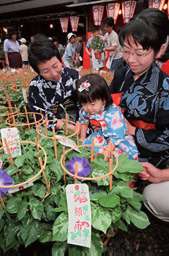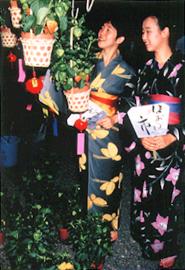|
 Summer
doesn't really seem to start in the older neighborhoods of Tokyo until
the arrival of the asagao ichi (morning glory fairs) and the
hozuki ichi (ground cherry fairs). Summer
doesn't really seem to start in the older neighborhoods of Tokyo until
the arrival of the asagao ichi (morning glory fairs) and the
hozuki ichi (ground cherry fairs).
During the three days from July
6, some 120 stalls of vendors lined the streets in the Iriya district
around Kishibojin Temple in Tokyo's Koto Ward, offering some 120,000
pots of red, pink, blue and purple morning glory plants.
As the name indicates, large funnel-shaped
asagao flowers open early in the morning and close by midmorning.
Many people therefore visited the fair from around seven in the morning,
some before they went to work. Pots priced at 2,000 yen (18 U.S. dollars
at 108 yen to the dollar) sold best, according to vendors.
Some people think pots of asagao
bought at the fair bring good luck, and so there were those who sent
them to relatives and friends as summer gifts using door-to-door parcel
delivery services. An estimated 400,000 to 600,000 people visited the
fair this year.
The asagao ichi dates back
to the early years of the Meiji period (1868-1912) and became a major
summer event in the 1880-90s. The fair in its present form was brought
back by local merchants in 1950.
Toshihiro Suzuki, 62, has been selling
the flowers at his own stall for 40 years. "Some of my customers run
through three generations. I really appreciate that kind of loyalty,
so I cannot quit," he said.
 Another
fair typical of summer in Tokyo's shitamachi (downtown) is the
hozuki ichi held July 9-10 in the compound of Asakusa Kannon
Temple in Taito Ward. Another
fair typical of summer in Tokyo's shitamachi (downtown) is the
hozuki ichi held July 9-10 in the compound of Asakusa Kannon
Temple in Taito Ward.
More than 100,000 pots of ground
cherries are sold each year, and about 80% of them come from a single
horticulturist named Takashi Suzuki. The hardest part of the work is
to grow them so that they turn really red on those particular two days
under whatever weather conditions, according to Suzuki. One pot sells
for 2,500 yen (23 dollars).
Of the two days of the fair, more
people come on July 10, the temple's special festival day, also called
shiman rokusen nichi (46,000 days), because one visit to the
temple on this particular day is said to be worth 46,000 ordinary visits.
During the Edo period (1603-1868),
the fair drew throngs who came to pray and buy not only hozuki
but also ears of corn believed to be effective in warding off thunder
and lightning.
Photos: Morning glories (top) and ground cherries (above)
are colorful symbols of summer in Tokyo. (PANA)
|

